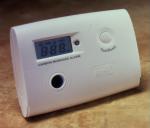Search engine visitors - click here to access entire "$ensible Home" web site
Click here to see a descriptive illustration showing several carbon monoxide detector/alarms.
Dear Jim: We have a newer home with a gas furnace, water heater and range. A nearby family was almost killed from carbon monoxide (CO) poisoning. Are we at risk with new appliances? Are home CO detectors available? - Mike D.

A: Although the chances of experiencing a problem with CO poisoning are not great with newer gas heating appliances, there certainly still is a risk. A flue can get clogged by an animal or debris or the appliance many just malfunction. Definitely install several home-type CO detector/alarms.
Your gas range is much less likely to create CO gas because it uses an open flame with plenty of oxygen available. Never use a gas range or oven to help heat your home though, even during an emergency. In a newer airtight home, the flame can lower oxygen levels in the air and then CO gas can begin to form.
CO gas is a "silent" killer (odorless, tasteless) that often occurs at night while people sleep. Its symptoms at low concentrations (headache, watery eyes, nausea, sleepiness, etc.) mimic the common cold or the flu. Without a CO detector, your family may be slowly getting poisoned at home.
There are many designs of CO detectors available for home use. Some are battery-operated, some are plugged into an electrical wall outlet and others are simple tablets that change color in the presence of CO gas. Some full-featured CO detectors start at only $25, so they are cheap protection.
It is a good idea to locate a CO detector in several areas of your house because each detector is typically only effective for the room where it is located. As a minimum, put one in the master bedroom so the parents will be alerted first and one in the utility room or furnace/water heater area.
One of the most convenient CO detectors is built into a clock radio for a bedroom. When CO is detected, a loud alarm beeps four times followed by a voice message to leave the room. This repeats every six seconds. There also is a red LED warning display that flashes to alert the hearing impaired.
Electronic CO detectors are effective and can also store the history of the CO gas levels in memory. If the alarm sounds, the fire department can access the recent CO concentration history in your home to help diagnose the source and determine the length of your exposure to the deadly gas.
Two-stage CO detectors provide a warning signal at low CO concentrations and the full alarm at dangerous levels. A flashing light or audible tone alerts you to a possible CO problem before the level gets too high.
Some electronic CO detectors allow you to use your TV remote control to start a self-diagnostic test. Use it regularly to make sure the detector is functioning properly.
Instant Download Update Bulletin No. 503 - buyer's guide of eight CO detector/alarms and tablet manufacturers (32 models) listing number of stages, power sources (plug-in, hardwired, battery), type of alarm (audible and/or visual) warranties, features, safety tips to help reduce CO levels, diagram showing potential CO sources in the home, chart showing effects of CO exposure, chart of health effects and sources of indoor combustion pollutants, illustrations and descriptions of various models.
Dear Jim: I had installed mirrors with construction adhesive on some walls to increase the brightness in a room and make it look larger. I want to remove the mirrors now. What is the best method to remove them? - Pat H.
A: Installing mirrors will increase brightness in a room with out adding more lamps. Glass mirrors can be dangerous to try to remove, so I always recommend having a professional glass/mirror contractor remove them.
If you must try it yourself, be very careful. Wear heavy clothing, thick leather gloves, workman's boots, and eye protection. Keep any children away. Warming the mirror with an electric hair dryer can sometimes soften the adhesive.